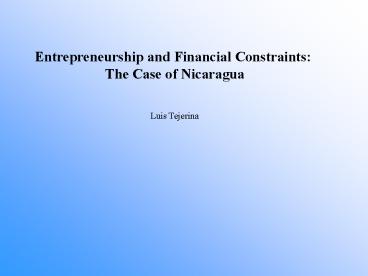Entrepreneurship and Financial Constraints: - PowerPoint PPT Presentation
1 / 20
Title:
Entrepreneurship and Financial Constraints:
Description:
This specific study is intended to explore the behavior of entrepreneurs with ... welcomes new enterprises is fundamental for developing countries (Stern 2001) ... – PowerPoint PPT presentation
Number of Views:220
Avg rating:3.0/5.0
Title: Entrepreneurship and Financial Constraints:
1
Entrepreneurship and Financial Constraints The
Case of Nicaragua Luis Tejerina
2
- Objective
- This specific study is intended to explore the
behavior of entrepreneurs with respect to
financial markets and to test for the existence
and types of constraints faced by potential
entrepreneurs. - The paper also intends to underline the need and
usefulness of gathering detailed financial
information in household surveys to monitor the
level of development of financial markets in LAC. - One of the benefits of this type of data is that
one is able to take a look at potential
entrepreneurs and try to discern the constraints
that keep them out of entrepreneurship.
3
- Why Nicaragua?
- Nicaragua was chosen for the study based on the
detail of the financial information included in
the 1998 Living Standards Measurement survey.
- Also Nicaragua experienced in the period under
study a spell of stable though moderate growth
(1.8 in per capita terms ) and increasing
inequality (Gini from .57 to .60). Any models of
this type are set under similar characteristics.
Nicaragua
4
Why Entrepreneurship?
- The development and understanding of
entrepreneurship has been recognized as a key
area for economic development, an environment
that welcomes new enterprises is fundamental for
developing countries (Stern 2001). - In Nicaragua small enterprises are an important
employment creator some studies put the
percentage of workers employed in enterprises
with less than 5 workers as high as 67.
5
- Urban Vs. Rural?
- In a recent survey Shane (2003) also presents
evidence from studies in economics and other
fields that find that urban areas present better
opportunities and positive externalities like
more access to role models and chance to spin-off
from bigger companies, one possibility is that
these factors can be substitutes for formal
education (e.g. learning to keep books by
observing the business next door, or learn the
skills as an employee and then create a separate
business).
6
How do entrepreneurs differ from non
entrepreneurs with relationship to the financial
sector?
7
What are the most frequent impediments to get
credit?
8
Sample
- This study follows the lines of an extensive
literature studying the relationship between
wealth and entry into entrepreneurship. - To avoid endogeneity problems (owning a business
increases wealth and more wealth increases the
probability of owning a business) the wealth
variable used is the retrospective wealth for 5
years ago. - In order to study only entrants into
entrepreneurship, all the households that had a
business for more than 5 years. - The sample is only composed of households who
either dont have a business or started their
first business in the previous five years.
Business owner who opened their second or third
businesses within the relevant period where also
omitted.
9
Entrepreneurship and Wealth
10
Entrepreneurship and Wealth
11
Entrepreneurship and Wealth
12
Entrepreneurship and Education
13
Entrepreneurship and Education
14
Entrepreneurship and Education
15
Evans Jovanovic (1989) Agents choose between
wage or self employment, agents differ in wealth
and entrepreneurial talent, can only borrow a
proportion of their wealth, if talent or wealth
too low will preffer wage employment, if talent
too high will be entrepreneurs but may be
constrained.
16
Aghion Bolton (1997) Moral hazzard problem,
low wealth people will be constrained since they
cannot guarantee the expected return required by
the market ( they need to borrow too much, which
hurts their incentives to put effort in their
projects). Market failures increase cost of
capital for low wealth entrepreneurs, and make
the probability of success rise faster with
wealth, while the first best probability of
success for investors is constant. A permanent
progressive redistribution policy increases
efficiency.
17
Identifying the type of constraint
18
(No Transcript)
19
Policy implications based on the moral hazard
model Policies that are consistent with the
moral hazard model will be those that help to
overcome the problem the bank has to verify the
effort exerted by the borrower in his
project. Policies of this type may be the
extension of joint liability groups to other
areas and institutions or perhaps the
implementation of credit bureaus. Policy
implications based on the limited commitment
model Land titling, eliminating restrictions on
the use of some types of collateral.
20
Conclusion Overall education, seems to be an
important determinant of entrepreneurship in
rural areas, and wealth seems to be the
determinant factor in urban areas, older heads of
household. Education programs, especially at the
secondary level seem to be important in the rural
areas for the creation of enterprises, the reason
could be that they enable the head of the
household to interact with financial markets that
cater to the poor.

